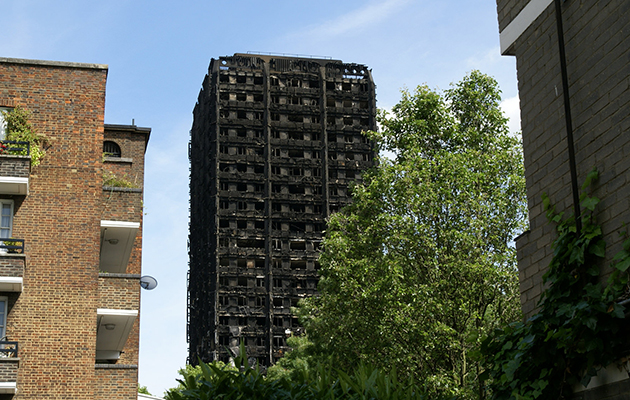|
|
||
|
Icon’s architecture correspondent identifies four major questions that will need to be addressed in the wake of last week’s disaster Two disasters at the turn of the 1970s had a huge effect on the built environment in the UK. The Ronan Point disaster of 1968, a progressive collapse of a system-built block that killed four, exposed wide-ranging shoddy construction and dodgy procurement, and is widely seen to have soured the mood towards high-rise construction. The Summerland disaster of 1973, in which 50 people lost their lives in a leisure centre fire that had spread through a cladding void, exposed the complacency with which innovative (and flammable) materials were being permitted for use in new buildings. I have written extensively on both these disasters, but I always thought of them as belonging to a previous era, where rules were loose, contracts were corrupt, and risky materials were ill-understood. I had no idea I could be quite so wrong. The fire at Grenfell Tower is a tragedy that should change everything. Much like the Hillsborough disaster of 1989, it seems that a whole class of people have been considered so unworthy of care that it has taken a mass death to bring their neglect into focus. Time and again in recent days the phrase ‘they died because they were poor’ has been heard, as countless complaints and recommendations are found to have been ignored, today’s building culture of sub-sub-subcontracting and relentless cost-cutting have had light shone on them, and those in positions of responsibility are basically absent, visible only behind rows of police security. At this early point, there are four major questions that will need to be addressed. All of them are linked, but while some of them will inevitably become part of a future inquiry, others are more fundamental in their scope. The most glaringly obvious aspect of the fire is the speed with which it spread across the outside of the building, and much of the focus so far has been on the aluminium-faced polyethylene panels that were recently installed as part of a refurbishment. The first question that needs to be answered is: is the particular cladding system used on Grenfell Tower inherently dangerous? That is, even if it’s installed perfectly, is this kind of accident still possible? If this is found to be the case, there could be hundreds of towers across the UK where the residents are at risk – not to mention millions of people worldwide. In the UK there needs to be an immediate audit of all re-clad jobs to ascertain who might be in danger, and it is reasonable to expect many blocks will have to have their cladding stripped out at great cost. The second question is: was this a botched job? In the 1960-70s, many towers were built where a basic lack of oversight meant that serious flaws were essentially ignored, leading to extremely heavy costs later as buildings were fixed or often demolished. In the case of Grenfell Tower, it is possible that substandard contracting and a lack of inspection and oversight contributed to this tragedy. Many people, myself included, have had bad experiences of estate refurbishment, and there is a perception that it is a cynic’s market – local authorities and housing associations that do not understand the works properly, contractors who ignore tenants’ concerns, and who ruthlessly bring the works down to the absolute minimum cost. Even before the tragedy, Grenfell Tower tenants were unhappy about their treatment, and there are huge questions regarding the extent to which this is a tragic outcome of routinely low-end contracting work. The contractors themselves have made statements that their works met all statutory requirements, which raises the third question: are the British building regulations sufficient? New-build residential buildings over 30m high have mandatory sprinkler systems, but for refurbishments this is currently only a recommendation. It is often said that British fire regulations are out of date and inadequate and, in comparison with Germany’s strict codes relating to tall buildings, they are clearly wanting. There have been a number of occasions in recent years, especially after another fatal tower block fire in 2009, where calls have been made for fire regulations to be strengthened. But the government failed to act on these calls, committed as it has been to reducing ‘red tape’ and regulation in general. The fourth question that must be addressed is: to what extent is this disaster the result of the general neglect of council tenants? The fire has occurred in the context of a generations-long ideological battle against social housing. Across the UK, but especially in London, council estates are currently being eyeballed for demolition and redevelopment to feed demand for private housing, as hundreds of new high-rise buildings (with sprinkler systems) are constructed for a different class of resident. There are a variety of incentives for councils and other landowners to demolish these estates, as the low-densities and the low wealth of the residents are holding the land back from more profitable use. Housing estates have suffered generations of physical and social neglect, and it is a terrible irony that this disaster has occurred seemingly as the result of refurbishment work. In the past – similar to the demonised football fans who died at Hillsborough – council tenants received the tabloid blame for issues of maintenance and safety in towers, all as part of an agenda of anti-state individualism. Add to this a generation of privatisation, with a profusion of companies involved in maintaining council housing stock, and the years of austerity, with councils strapped of funds and benefits to the vulnerable constantly being cut back, and it’s hard not to ask whether a disaster like this is a hideous outcome of years and years of telling everyone involved to do ‘more with less’. It’s still hard to believe an accident this awful has occurred in 2017, and while it will be a long time before anyone can say for certain what actually happened, all of the questions raised above involve issues of neglect, of ordinary citizens being treated as unimportant. It cannot be denied that it’s extremely difficult and expensive to look after thousands of large buildings half a century old, and we should bear in mind the complexity and difficulties of the situation, and that there may well in the end be no individual villains. But it’s hard not to see long-running political and economic struggles as being the forces that created the conditions for this to happen. The biggest question now is: what is to be done? |
Words Douglas Murphy
|
|
|
||

















